|
|
|
|
|
Abit IT7 Max 2 (Intel i845E) Motherboard |
|
Join the community - in the OCAU Forums!
|
Phase-Change Cooling and Conclusions
Overclocking the IT7 Max 2 with Phase-Change Cooling
Finally, we mounted the IT7 Max 2 in our Vapochill case and prepared our P4 2.66 for the great freeze. A short introduction into the Vapochill technology (from the Asetek website): The VapoChill cooling system works like a household refrigerator. An evaporator is transferring the heat from the CPU into the refrigerant. The warm, gaseous refrigerant is sucked from the evaporator into the compressor, where the pressure is raised to the condensation pressure of the refrigerant in order for the phase change to occur. The heat gathered from the evaporator is expelled through the condenser, where the refrigerant is liquefied in the process. In order for the refrigerant to evaporate again it is necessary to lower the pressure using some sort of valve. By using a capillary tube (i.e. a tube with a small inner diameter) the same pressure drop can be obtained, before being send into the evaporator.
When running our P4 2.66 at 1.85 (default is 1.525) volts, the evaporator was at minus 20 C and the CPU at around zero C. Reducing the voltage and/or the CPU frequency is naturally decreasing the CPU temperature further. So, it’s important to find the best compromise between low CPU temperature and high voltage/CPU frequency. Recently we had problems installing other, bigger boards like the A7V333 in the mid-tower Vapochill case. The IT7 Max 2 however fits perfectly. The IT7 Max 2 CPU socket is also well located for the perpendicular placement of the evaporator on the CPU die or on the heat spreader in case of a P4. The IT7 Max 2 is certainly a good choice for the use with the current Vapochill system.
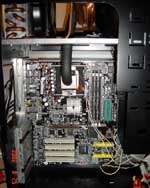 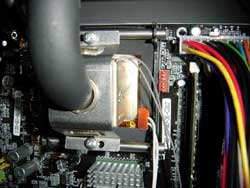
A vapochilled system has 2 advantages. Firstly and most important: the CPU overclocks higher because of the much lower temperature in comparison with an air-cooled CPU. Secondly at the same frequency a vapochilled CPU runs more stable than an air-cooled CPU. With the vapochilled 2.66 on the IT7 Max 2 we eventually managed to boot into Windows 2000 at 3709 MHz. This is around 300 MHz more than the maximum CPU frequency we achieved air-cooled. In order to run our benchmarks 100% stable we had to scale back the CPU frequency from 3709 to exactly 3500 MHz. This is a very good result considering that with our previously tested 2.26 on the BD7-II we got only around 140 MHz on top of the air-cooled result. It shows again that the IT7 Max 2 is providing an excellent platform for P4 overclocking. The additional CPU frequency of 220 MHz achieved with the Vapochill cooling system gave us 4% to 5% additional application performance on top of our best results with the air-cooled P4 2.66.
Finally we mated this high performing vapochilled IT7 Max 2 with ATI’s Radeon 9700. As shown in our recent review the Radeon 9700 is the current king of video cards, and running it on this vapochilled IT7 Max 2 was very tempting. The performance of a video card is of course mainly determined by the GPU and the video memory. But only the combination with a highly overclockable mainboard is resulting in extreme performance. To make a rather long story short: at the very end we managed to run the (unmodified) Radeon 9700 GPU at 410 MHz and the memory at 365 MHz and at the same time the IT7 Max 2 at 3480 MHz. What we then saw was truly eye popping. After 3D marks of up to 11,000 with the maxed out GF3 TI500 we got with exactly the same P4 2.66 and IT7 Max 2 now a 3Dmark 2001 SE default score of almost 18,900 3D Marks. This was, at that time, one of the highest scores ever registered in the MadOnion data base with an unmodified, air-cooled video card and another indicator for the excellent performance potential and stability of the IT7 Max 2.
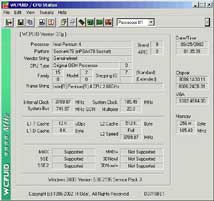 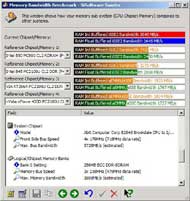 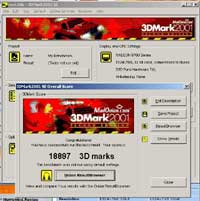
Note: In the graphs below we refer to the IT7 Max 2 as "IT7-II" for short. We have since learned that there will be another, different, motherboard that actually carries the name "IT7-II". So please keep in mind that, in the graphs below, that name is only our short-hand name for the motherboard in this review, the IT7 Max 2, and is not intended to reflect the performance of the not-yet-released IT7-II.
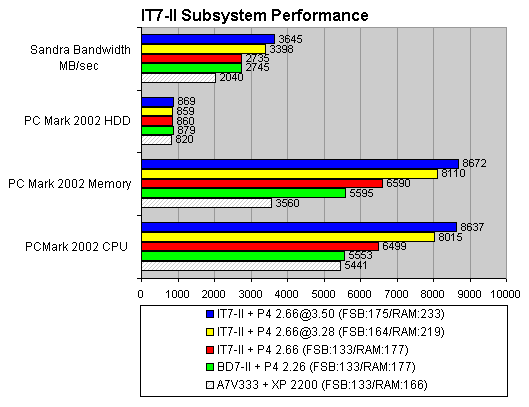
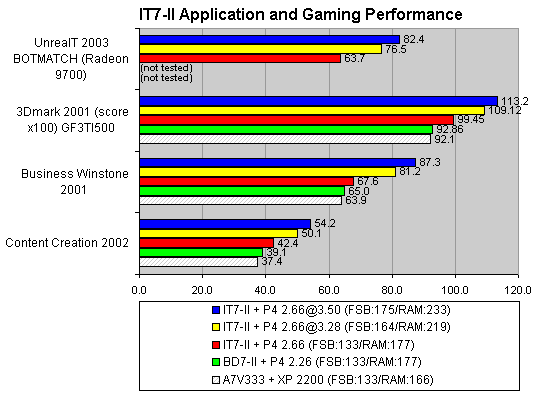
Conclusions:
| Overclocking Results with IT7 Max 2 | Device | Best Value / Score | | CPU Frequency (air-cooled) | P4 2.66 with heat-pipe based IHC-H71 | 20x170 = 3400MHz | | CPU Frequency (phase-change cooled) | P4 2.66 with Vapochill | 20x185.5 = 3709MHz | | RAM frequency (in FSB:RAM = 3:4) | Twinmos PC 3200/Winbond DDR 400 at 2.5-7-3-3 | 238MHz | | Bandwidth | Twinmos PC 3200/Winbond DDR 400 at 2.0-6-3-3 | 3645MB/sec | | 3DMark 2001 SE | Radeon 9700 at 410MHz core / 365MHz memory | 18897 3DMarks |
Pros:- Excellent application performance
- Best-in-class overclocking potential
- Spotless finish quality
- USB 2.0, Firewire, LAN
- 6-channel sound with 5 separate audio connectors and SPDIF out
- Parallel ATA 133 and Serial ATA 150 RAID controller with 4 channels
- “Seriall” (parallel ATA to serial ATA) converter
- on-board LED diagnostics and on-board power and reset switch
- optional Media XP with card reader function for memory sticks, secure digital and CompactFlash
Cons:The IT7 Max 2 is by features and performance the best Pentium 4 mainboard I have tested so far. The revised MAX concept including the innovative hybrid serial + parallel RAID can 100% convince and the test performance was excellent. And last but not least: the IT7 Max 2 is the best P4 overclocking platform I am aware of. I highly recommended this mainboard. The price with around 185 USD is appropriate considering that the added value of the integrated SATA RAID function alone covers more than the distance to cheaper but less equipped boards.
Check out the Top 10 entries in the PC Database!
|
|
Advertisement:
All original content copyright James Rolfe.
All rights reserved. No reproduction allowed without written permission.
Interested in advertising on OCAU? Contact us for info.
|

|


